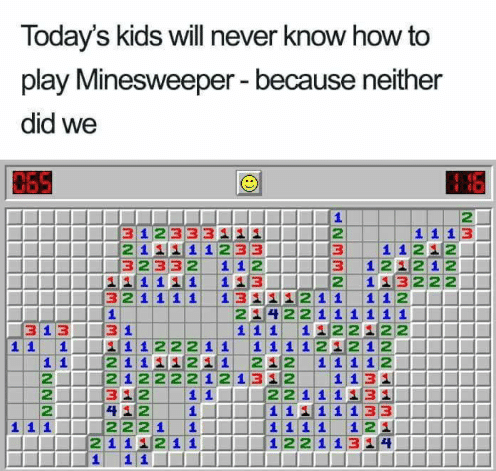How To Play Minesweeper in 2021: This wikiHow teaches you how to dance Minesweeper on a Windows calculator. Although Minesweeper no longer comes pre-installed on Windows computers, you can load the remastered version from the Aperture 10 Store for free. Start with a good mouse and mousepad.
Your mouse must contribute solid control and veracity. I’m using an old Logitech MX518 set to 800 dpi with the nervousness at the third position in the Windows discipline panel and mouse expedition turned off. Also, manufacture sure your desk can’t shake and position your chair at a good level—too high, and you’ll have a hard time gripping the mouse. Too low, and your hand will hurt.

How To Play Minesweeper On Google
Enrolling to read these patterns is like enrolling to read a language. In the beginning, it takes a lot of time to remember every single letter, but after a few years, you can read instantaneously, without any effort. It’s the same with enrolling patterns—after three years of playing Minesweeper a few hours a day, you don’t have to think about where the mines are when you see these arrangements.
If you play controlling flags, employ the “double-click” technique (press the left and right mouse buttons at the same time). This action opens all squares inundating a square with a number if you have pronounced the number of mines around that number. In the example below, you mark a mine in an intersection and then double-click on the circled 1 to open the surrounding four squares simultaneously. This concept is faster than opening four safe squares independently using the left-click.
In the scene shown above, the centers I’ve marked with a red dot present a 50 percent chance of losing, while the square with the green dot has only a 15.625 percent (Beginner and Intermediate) or 20.625 percent (Professional) chance to lose. Stop by Authoritative Minesweeper, the online home of the Minesweeper neighborhood. You can find information about world evidence, a Minesweeper wiki, live tournaments, and plenty of tips. To join the World Ranking, your time records on neophyte, Intermediate, and Professional must add to less than 100 seconds.
How To Play Minesweeper in 2021

Minesweeper is a single-player puzzle video game. The objective of the game is to clear a rectangular board containing hidden “mines” or bombs without detonating any of them, with help from clues about the number of neighboring mines in each field. The game originates from the 1960s and has been written for many computing platforms in use today. It has many variations and offshoots.
Some versions of Minesweeper will set up the board by never placing a mine on the first square revealed. Minesweeper for versions of Windows protects the first square revealed; from Windows 7 onward, players may elect to replay a board, in which the game is played by revealing squares of the grid by clicking or otherwise indicating each square. If a square containing a mine is revealed, the player loses the game. If no mine is revealed, a digit is instead displayed in the square, indicating how many adjacent squares contain mines; if no mines are adjacent, the square becomes blank, and all adjacent squares will be recursively revealed. The player uses this information to deduce the contents of other squares, and may either safely reveal each square or mark the square as containing a mine.
How To Play Minesweeper Game
Minesweeper has its origins in the earliest mainframe games of the 1960s and 1970s. The earliest ancestor of Minesweeper was Jerimac Ratliff’s Cube. The basic gameplay style became a popular segment of the puzzle video game genre during the 1980s, with such titles as Mined-Out (Quicksilva, 1983), Yomp (Virgin Interactive, 1983), and Cube. The cube was succeeded by Relentless Logic (or RLogic for short), by Conway, Hong, and Smith, available for MS-DOS as early as 1985; the player took the role of a private in the United States Marine Corps, delivering an important message to the U.S. Command Center. Re-Logic had greater similarity to Minesweeper than to Cube in concept, but a number of differences exist:
- In RLogic, the player must navigate through the minefield, from the top left right-angled corner to the bottom right-angled corner (the Command Center).
- It is not necessary to clear all non-mine squares. Also, there is no mechanism for marking mines or counting the number of mines found.
- The number of steps taken is counted. Although no high score functionality is included, players could attempt to beat their personal best score for a given number of mines.
- Unlike Minesweeper, the size of the minefield is fixed. However, the player may still specify the number of mines.
- Because the player must navigate through the minefield, it is sometimes impossible to win — namely, when the mines block all possible paths.
The gameplay mechanics of Minesweeper are included in a variety of other software titles, including:
- The mini-game Vinesweeper implemented into the MMORPG RuneScape; in this iteration (written by Jagex developer Danny J), the Minesweeper gameplay is given a large multiplayer aspect and the “game board” adopts a continually resetting timer. This allows for a never-ending game of Minesweeper where the skill is assessed in points rather than “game completion”.
- The PC game Mole Control (developed by Remote); in this game, the Minesweeper mechanic is integrated into a puzzle adventure game based in a village called Molar Creek, which has been overrun with exploding moles. The player acts as the local inventor’s assistant, who is tasked with clearing the village of exploding moles. A time attack mode, called the Molar Creek Annual Mole Control competition, is also available.
How To Play Minesweeper Without Guessing
Unlike many games and features built by corporations today, Minesweeper was built during a time where developers and computer scientists were largely hobbyists at heart. The first iterations of Minesweeper as we know it was built by Robert Donner who was hired by Microsoft in 1989. Originally a programming exercise by Donner, it’s now one of the most iconic computer games next to the likes of Pong and Tetris.
Donner noted that, while he worked for the company, Minesweeper was written by himself, in his own time, and freely distributed within the company. It was a hobby that followed years of development, changing through some of the earliest forms of AB testing (watching his friends play the game) and never followed strict timelines or budgets. It was, however, a rare case of when an intended audience eventually emerged, and the game developed a new function while the functionality itself remained. Minesweeper was selected for release on Windows 3.1 in 1992 as a tool to get users used to right-clicking by placing down flags.
Understand the principles behind Minesweeper
Each Minesweeper game starts out with a grid of unmarked squares. After clicking one of these squares, some of the squares will disappear, some will remain blank, and some will have numbers on them. It’s your job to use the numbers to figure out which of the blank squares have mines and which are safe to click.
- Minesweeper is similar to a Sudoku puzzle in that your success is largely contingent on being able to eliminate possible answers until only one answer remains.
Use the mouse’s left and right buttons
The mouse is the only tool that you’ll need to play Minesweeper. The left mouse button is used to click squares that don’t contain mines, while the right mouse button is used to flag squares that contain mines.
- On higher difficulties, you’ll need to mark squares that you suspect contain mines until you can verify that they do contain mines.



